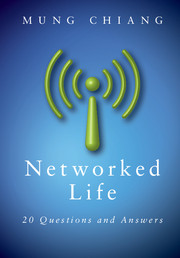Book contents
- Frontmatter
- Contents
- Preface
- Acknowledgements
- Roadmap
- 1 What makes CDMA work for my smartphone?
- 2 How does Google sell ad spaces?
- 3 How does Google rank webpages?
- 4 How does Netflix recommend movies?
- 5 When can I trust an average rating on Amazon?
- 6 Why does Wikipedia even work?
- 7 How do I viralize a YouTube video and tip a Groupon deal?
- 8 How do I influence people on Facebook and Twitter?
- 9 Can I really reach anyone in six steps?
- 10 Does the Internet have an Achilles' heel?
- 11 Why do AT&T and Verizon Wireless charge me $10 a GB?
- 12 How can I pay less for each GB?
- 13 How does traffic get through the Internet?
- 14 Why doesn't the Internet collapse under congestion?
- 15 How can Skype and Bit Torrent be free?
- 16 What's inside the cloud of iCloud?
- 17 IPTV and Netflix: How can the Internet support video?
- 18 Why is WiFi faster at home than at a hotspot?
- 19 Why am I getting only a few % of the advertised 4G speed?
- 20 Is it fair that my neighbor's iPad downloads faster?
- Index
- Notes
16 - What's inside the cloud of iCloud?
Published online by Cambridge University Press: 05 November 2012
- Frontmatter
- Contents
- Preface
- Acknowledgements
- Roadmap
- 1 What makes CDMA work for my smartphone?
- 2 How does Google sell ad spaces?
- 3 How does Google rank webpages?
- 4 How does Netflix recommend movies?
- 5 When can I trust an average rating on Amazon?
- 6 Why does Wikipedia even work?
- 7 How do I viralize a YouTube video and tip a Groupon deal?
- 8 How do I influence people on Facebook and Twitter?
- 9 Can I really reach anyone in six steps?
- 10 Does the Internet have an Achilles' heel?
- 11 Why do AT&T and Verizon Wireless charge me $10 a GB?
- 12 How can I pay less for each GB?
- 13 How does traffic get through the Internet?
- 14 Why doesn't the Internet collapse under congestion?
- 15 How can Skype and Bit Torrent be free?
- 16 What's inside the cloud of iCloud?
- 17 IPTV and Netflix: How can the Internet support video?
- 18 Why is WiFi faster at home than at a hotspot?
- 19 Why am I getting only a few % of the advertised 4G speed?
- 20 Is it fair that my neighbor's iPad downloads faster?
- Index
- Notes
Summary
A Short Answer
In June 2011, Apple announced its iCloud service. One of the eye-catching features is its digital rights management of music content. The other part is its ability to let you essentially carry your entire computer hard drive with you anywhere and stream music to any device.
Cloud is more than just storage. For example, in the same month, Google introduced ChromeBook, a “cloud laptop” that is basically just a web browser with Internet connectivity, and all the processing, storage, and software are somewhere in Google servers that you access remotely.
These new services and electronics intensify the trends that started with web-based emails (e.g., Gmail), software (e.g., Microsoft Office 365), and documents (e.g., Google Docs and Dropbox), where consumers use the network as their computers, the ultimate version of online computing.
In the enterprise market, many application providers and corporations have also shifted to cloud services, running their applications and software in rented and shared resources in data centers, rather than building their own server farms. Data centers are facilities hosting many servers and connecting them via many switches. Large data centers today is typically over 300,000 square feet, house half a million servers, and cost hundreds of millions of dollars to build.
There are three major cloud providers as of 2012: Amazon's EC2, Microsoft's Azure, and Google's AppEngine. A pioneering player in cloud services is actually Amazon, even though to most consumers Amazon stands for an online retail store.
- Type
- Chapter
- Information
- Networked Life20 Questions and Answers, pp. 358 - 379Publisher: Cambridge University PressPrint publication year: 2012



